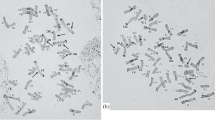Summary
A complete set of isogenic wheat/rye D-genome substitutions were produced by crossing an inbred line of spring rye Secale cereale L. cv. “Prolific” to a tetraploid wheat, the A-and B-genomes of which had previously been extracted from hexaploid wheat, Triticum aestivum L. em Thell. cv. “Thatcher”. After chromosome doubling, the derived hexaploid triticale (x Triticosecale Wittmack) was backcrossed to 6x “Thatcher” and selection for wheat/rye substitution lines was carried out in BCF3 to BCF6 families by using Giemsa C-banding. Five fertile disomic wheat/rye D-genome substitution lines were obtained and their chromosomal constitution was determined to be 1D/1R, 2D/2R, 7D/4R, 6D/6R, 7D/7R. The two remaining 3R and 5R substitutions are at the moment in a monosomic condition. Another 1D/7R substitution was detected but this plant was very weak and sterile, indicating that only substitutions between homoeologous chromosomes result in fertile, vigorous plants. Furthermore, many rye telocentrics as well as rye-rye and rye-wheat translocations were selected. Since all lines selected in this program share the same genetic background of “Thatcher” wheat, genetic heterogeneity is excluded. The material is very useful, therefore, for analyzing the effects of different rye chromosomes or chromosome segments in an otherwise homozygous background.
Similar content being viewed by others
References
Appels R (1982) The molecular cytology of wheat-rye hybrids. Int Rev Cytol 80:93–132
Bushuk W, Larter EN (1982) Triticale: Production, chemistry and technology. Adv Cereal Sci Technol 3:115–157
Endo TR (1986) Complete identification of common wheat chromosomes by means of the C-banding technique. Jpn J Genet 61:89–93
Endo TR, Gill BS (1983) Identification of wheat chromosomes by N-banding. Proc 6th Int Wheat Genet Symp Kyoto, pp 355–359
Endo TR, Gill BS (1984) Somatic karyotype, heterochromatin distribution and nature of chromosome differentiation in common wheat, Triticum aestivum L. em Thell. Chromosoma 89:361–369
Giraldez R, Cermeño MC, Orellana J (1979) Comparison of C-banding pattern in the chromosomes of inbred lines and open pollinated varieties of rye, Secale cereale L. Z Pflanzenzücht 83:40–48
Gupta PK (1971) Homoeologous relationship between wheat and rye chromosomes. Present status. Genetica 42:199–213
Gupta PK, Priyadarsham K (1982) Triticale: present status and future prospects. Adv Genet 21:255–345
Gustafson JP (1983) Cytogenetics of triticale. In: Swaminathan MS, Gupta PK, Sinha U (eds) Cytogenetics of crop plants. McMillan, New York, pp 225–250
Iordansky AB, Zurabishvili TB, Badaev NS (1978) Linear differentiation of cereal chromosomes. I. Common wheat and its supposed ancestors. Theor Appl Genet 51:145–152
Kaltsikes PJ, Evans LE, Bushuk W (1968) Durum-type wheat with high breadmaking quality. Science 159:211–213
Kaltsikes PJ, Evans LE, Larter EN (1970) Chromosome segregation in hybrids between extracted AABB tetraploids and common wheat varieties. Cytologia 35:242–251
Kaltsikes PJ, Gustafson JP, Lukaszewski AJ (1984) Chromosome engineering in triticale. Can J Genet Cytol 26:105–110
Kerber ER (1964) Wheat: Reconstruction of the tetraploid component (AABB) of hexaploids. Science 143:253–255
Lukaszewski AJ, Gustafson JP (1983) Translocations and modifications of chromosomes in triticale x wheat hybrids. Theor Appl Genet 64:239–248
Merker A (1976) Chromosome substitution, genetic recombination and the breeding of triticale. Wheat Inf Ser 41–42:44–48
Miller TE (1984) The homoeologous relationship between the chromosomes of rye and wheat. Current status. Can J Genet Cytol 26:578–589
Rimpau W (1981) Kreuzungsprodukte landwirtschaftlicher Kulturpflanzen. Landwirtsch Jahrb 20:335–371
Schlegel R, Melz G, Mettin D (1986) Rye cytology, Cytogenetics and genetics — Current status. Theor Appl Genet 72:721–734
Sears ER (1966) Nullisomic-tetrasomic combinations in hexaploid wheat. In: Riley R, Lewis KR (eds) Chromosome manipulations and plant genetics. Oliver and Boyd, Edinburgh Suppl Hered 20:29–45
Sears ER (1968) Relationships of chromosomes 2A, 2B and 2D with their homologue. Proc 3rd Int Wheat Genet Symp, Canberra, pp 53–61
Skovmand B, Fox PN, Villareal RL (1984) Triticale in commercial agriculture. Adv Agron 37:1–45
Zeller FJ, Cermeño MC (1988) Chromosome manipulations in Secale. In: Tsuchiya R, Gupta PK (eds) Chromosome engineering in plant genetics. Elsevier, Amsterdam (in press)
Zeller FJ, Hsam SLK (1983) Broadening the genetic variability of cultivated wheat by utilizing rye chromatin. Proc 6th Int Wheat Genet Symp, Kyoto, pp 161–173
Zeller FJ, Koller CL (1981) Identification of a 4A/7R and 7B/4R wheat-rye chromosome translocation. Theor Appl Genet 59:33–37
Author information
Authors and Affiliations
Additional information
Communicated by K. Tsunewaki
Contribution No. 797
Rights and permissions
About this article
Cite this article
Friebe, B., Larter, E.N. Identification of a complete set of isogenic wheat/rye D-genome substitution lines by means of Giemsa C-banding. Theoret. Appl. Genetics 76, 473–479 (1988). https://doi.org/10.1007/BF00265353
Received:
Accepted:
Issue Date:
DOI: https://doi.org/10.1007/BF00265353




